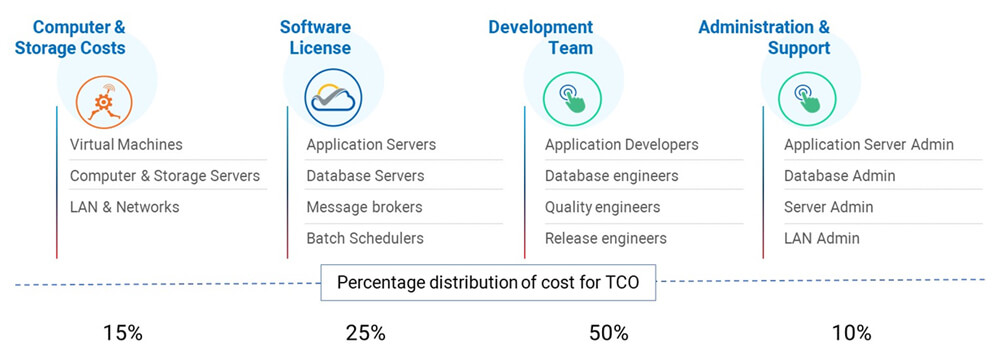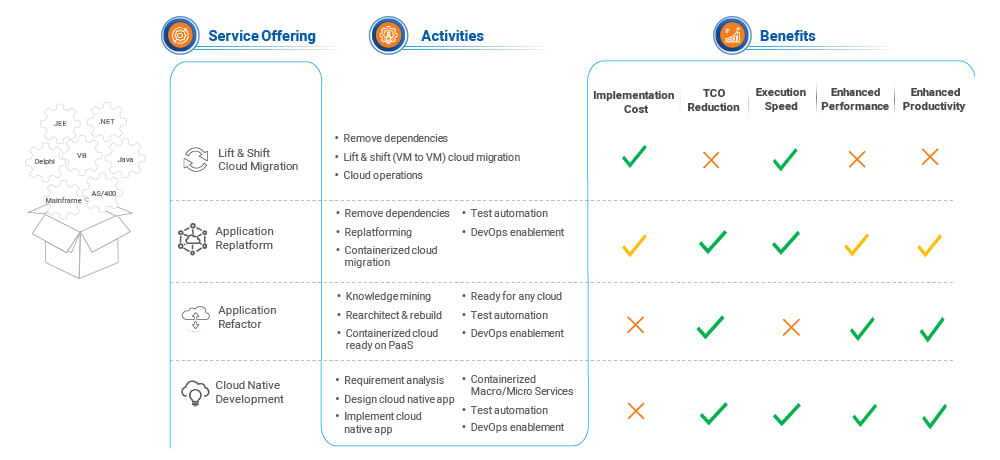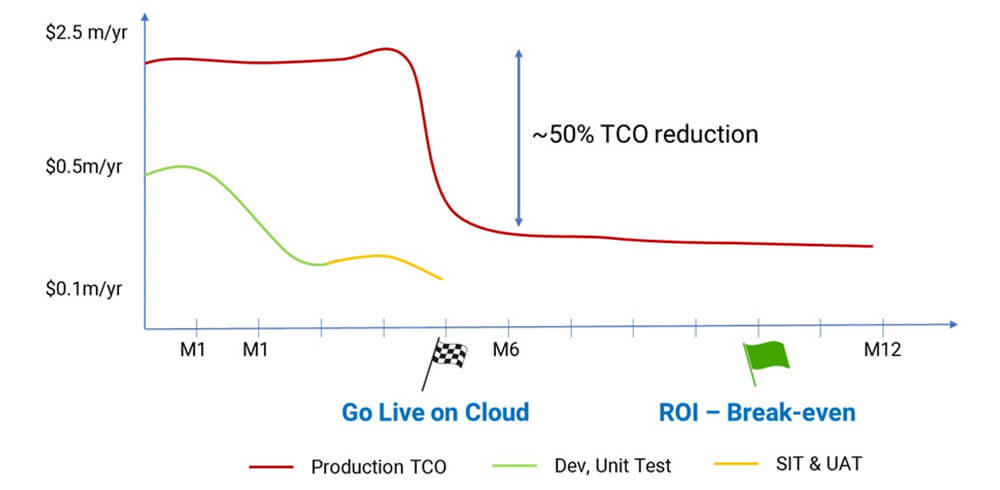This website uses cookies. By continuing to browse the site, you are agreeing to our use of cookies
Derive Optimized ROI, Right from the First Year for your Cloud Replatforming Projects
Cloud
June 19, 2020
Overview
The most important question that every CxO is trying to answer is “How do I realize TCO savings within the first year of migrating applications to Cloud?” This question was always important, however in the post COVID world, the importance of this question will go up exponentially as budgets become very tight. The second important question is “Can I minimize or eliminate risks in cloud migration projects?” This blog provides insights into both these questions, to help CxOs and their teams in easier decision-making.
Critical Factors affecting TCO
First, let us consider the four important factors that have a major impact on TCO. They are:
- Computer and storage cost – These are the costs associated with computer servers, network storage and network costs. In an on-prem world these costs are mostly associated with data center costs and each application would be assigned a portion if these resources are not dedicated.
- Software licenses – These are licenses for various software that would be required to run various applications.
- Administration – Cost of staff to administer and maintain the software and hardware for these applications. In most cases these are shared costs.
- Development team – Cost of development, testing and deployment professionals. This cost will be very high for applications that have a roadmap while significantly lower for applications that are stable without active releases.
The following image gives a detailed breakdown of the costs for an application with active release plan along with an indicative percentage contribution to the overall TCO.

Different cloud migration options can impact the TCO to varying degrees and the following sections highlight these:
Cloud Migration Options and their Impact on TCO
There are four options to migrate an existing application to Cloud, popularly termed as the 4Rs. They are:
- Rehost (Lift and Shift)
- Replatform
- Refactor
- Rewrite
The benefits or business impact of cloud migration can be measured by the following five parameters which are:
- Implementation costs
- TCO reductions
- Execution speed
- Enhanced application performance
- Enhanced development productivity
The following table maps the four cloud migration options to the five benefits for making an informed business decision on choosing the right option.

As you can see from the above displayed diagram, cloud replatform appears to be the one that is most promising with cloud refactor coming in as the next best option. Cloud replatform option can give the maximum TCO benefits due to the potential for eliminating various license costs and also the ability to increase application performance and development productivity.
If the implementation cost of cloud replatform can be reduced by bringing in automation, these options would be even more attractive. This is exactly what Hexaware does with their amaze® for Applications product which brings automation in cloud replatform projects. With the use of amaze®, the cloud replatform row would look like:

Now choosing the right cloud migration option becomes a no-brainer and cloud replatform with automation (amaze®) becomes a clear winner.
Replatform with Automation
Cloud replatform activity involves a series of steps that will have to be done for each application and which consumes significant amount of time and cost. These steps are outlined as follows:
- Upgrades to libraries like JDK, Spring, .Net, etc.
- Removing sessions to make the cloud application stateless
- Converting on-prem design patterns and frameworks like EJBs to cloud friendly patterns and framework with Spring
- Replacing on-prem message brokers like IBM, Tibco to cloud friendly message brokers like Active MB
- Replacing batch schedulers like Autosys with AWS batch
- Replacing Application servers like WebLogic, WebSphere and JBoss with Tomcat
- Replatforming expensive DBs like Oracle, Sybase, DB2 with Postgres
amaze® for Applications from Hexaware can automate most of the above mentioned tasks and can drastically reduce efforts and time. For more details on how amaze® accomplishes these tasks, you can request a demo by writing to amaze@hexaware.com.
For this article, the focus is on realizing ROI within 12 months.
Typical Timeline
A typical cloud replatform project with amaze® involves the following steps:
- Application Design – Design process to define technology stack and deployment view of the newly replatformed applications
- Development and Unit Test – These are the phases where the actual code changes for replatforming happens along with creation of unit test cases for the new code
- SIT and UAT – Testing the newly replatformed application for end-to-end features with production data
- Product Roll-out – Deploying into production environment and cut-over from the old application to the new one
In most cases automation led replatforming using amaze®, Design, Development and Unit Testing can be completed in 4 – 6 weeks to get the application to a SIT ready state. Compared to the manual approach which can take 6+ months this is a significant saving in terms of time and cost.
Return on Investment (ROI)
In cloud replatform projects, ROI starts at the point, where the initial investment or cost to replatform the application to cloud is recovered by reduction in monthly operating cost. This can also be called as the break-even point from a financial standpoint. In simple terms if $500k was spent on cloud replatforming and post replatforming if there is a $100k reduction in monthly TCO, then it would take 5 months to hit break-even or the point where this project would turn financially profitable.
The graph below highlights various tasks in cloud replatforming along with TCO plotting where cost is represented on the Y axis and timeline in months on the X axis for an application that was replatformed by Hexaware using amaze® for Applications.

As illustrated in the graphical representation, the following are the key milestones:
- Development and unit test complete with the application getting to SIT ready state by month 2
- SIT and UAT completed by month 5
- Production deployment by month 5
- ROI – Break even by month
Due to accelerated replatforming and reduction in time, an even ROI can be achieved. Also, investments start giving positive returns from the first month itself, which is very attractive.
Eliminating Risk or Outcome Based Delivery Model
Having eliminated the ROI question, the next important question that comes in every CIO or Technology decision maker’s mind is, “What is the risk involved and will this approach work?” This is a very valid question with any new technology like amaze® for Applications.
The simple answer to this question is to engage with companies like Hexaware in an output-based engagement model, where Hexaware gets paid only after the application passes SIT. In this model, the risk of the project gets eliminated completely and customers have nothing to lose in trying out this new technology to migrate applications to cloud. To get started write to amaze@hexaware.com for a detailed, free assessment and implementation plan.
Conclusion
In summary, the three important factors to achieve ROI within the first year are the following:
- Accelerating replatform leveraging automation which can reduce implementation time to within 6 weeks
- Reduced cost of implementation leveraging automation
- Adoption of open source software like Tomcat, Postgres, Spring and others to reduce the licensing costs associated with servers like application, database, message brokers, etc.
To add to the above dimension, an output-based model will further reduce or eliminate the risks associated with cloud replatform projects.
To get detailed insights into the potential TCO savings write to amaze@hexaware.com and get started with a free assessment.
About the Author

Vinodh Arjun
Read more
Related Blogs

Understanding Snowflake Cortex for Gen AI Applications with Sensitive Data
- Generative AI
- Cloud
- Data & Analytics

Ready to Pursue Opportunity?
Every outcome starts with a conversation
















